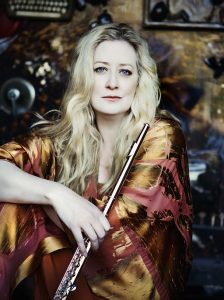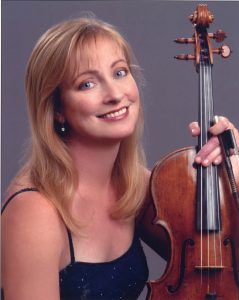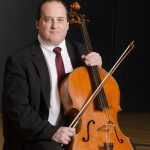Saturday evening’s Mainly Mozart Spotlight Series at The Scripps Research Institute Auditorium presented (mostly) fabulous playing of (generally) lighter weight musical fare. The result was an extremely satisfying program that was on the short side (90 minutes.) No one left feeling cheated.
Mozart’s Flute Quartet No. 3 in C Major, K.285b, opened. Flute players adore Mozart’s output for their instrument with good reason. Relatively speaking, the flute lags far behind the piano, violin and even the cello in truly great repertoire. Consequently, any utterance of the great masters to their instrument is considered by flutists to be on the same level as the greatest repertoire. By and large, unfortunately, the flute pieces are not even close to the same level, but no matter. They shall be played!

Tara-Helen-OConnor [photo courtesy of Mainly Mozart]
Although we have four flute quartets by Mozart, three authorized and one spurious, they are all decidedly low calorie fare. Regardless, flutist Tara Helen O’Connor, violinist Daniel Phillips, violist Cynthia Phelps and cellist Ronald Thomas brought a commitment to treat the C Major Quartet with great care and performed the piece charmingly, brimming with zest and life. It was comforting that these fine musicians took the meek little piece so seriously, and their efforts were rewarded by a first rate performance. Rhythmic accuracy and spot on intonation accompanied seamless phrasing and effective dynamics.
What followed, however, was a deadly rendition of “Syrinx” composed by Tara Helen O’Connor–I mean Claude Debussy. To explain, 99% of the world’s flutists play this piece, and the vast majority of them seem to think that their unique ideas about rhythm, dynamics and articulations are much better than anything than that Debussy ever wrote. One of O’Connor’s teachers, Thomas Nyfenger, in fact, felt so intensely about the pervasive and dishonest mangling and “recomposing” of the piece that he developed a sarcastic and hilarious pedagogic lecture called “24 Variations on Syrinx,” in which he demonstrated twenty four of the most common butcherings of poor little “Syrinx.” O’Connor presented us with many of those perversions on Saturday night. Such a shame to do this to a composer who once told the grand old man of the flute, Marcel Moyse (who premiered the work), “Play the notes. I don’t need any collaborators!” O’Connor was nonetheless capable of delivering a strongly atmospheric performance. Too bad it wasn’t Debussy’s piece. It would have been better than O’Connor’s, which was pretty good, nonetheless.
The next ditty, the Duo for Flute and Viola in C minor, Op.5, No.3 by François Devienne (1759-1803) was truly delightful (shouldn’t all ditties

Cynthia Phelps [photo (c) Christian Steiner]
be delightful?). This rarity, written by the first
Professeur de la flûte at the Paris Conservatory (thus, arguably, one of the inventors of “modern” flute playing) was a little firecracker of a piece that kept both musicians on their toes. It snapped with technical difficulties that both O’Connor and Phelps tossed off with virtuosic aplomb. The Duo was a perfect palette cleanser before the
pièce de résistance of the evening that followed.

Daniel Phillips [photo courtesy of Mainly Mozart]
Beethoven String Trio. Those three words always bring a smile to my face. Written around 1797 and thus considered early Beethoven, these babies are redolent of the fully formed master. His life long obsession with structural unity through a nearly constant and searching development, the bold Teutonic joking of his scherzi, and the pure, straight fire that Beethoven brings to the table with these pieces is impressive. And these musicians absolutely nailed the gnarly passage work and tricky rhythmic “gotchas” throughout the work. Perhaps most impressive was the absolute lack of pretense or affectation in their interpretation. Oh my, how utterly refreshing it was to basically
just hear the Master’s music, performed with virtuosity, conviction and above all, musical honesty.

Ronald Thomas [photo courtesy of Mainly Mozart]
The trio’s sound was most impressive. The “bloom” of the string timbres was reminiscent of a fine Chateau-Lafitte Rothschild that continued to open as the evening progressed. The rich orchestral experience of the players (especially Phelps, who is the long time Principal Violist of the New York Philharmonic) obviously contributed to an unassailable rhythmic time feel. The pulse did not budge, unless the musicians specifically willed it to happen. Their intonation was accurate, and their unified bow phrasings showed us once again that these performers spent the requisite time rehearsing to make this little masterpiece gleam. The subtle virtuosity of the viola part displayed utter mastery of its brutal demands. Would that every attempt at the standard classical repertoire approach this level of commitment, excellence and brilliance.




